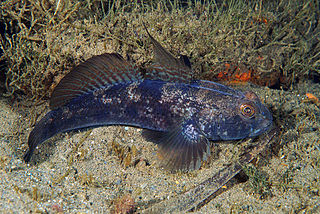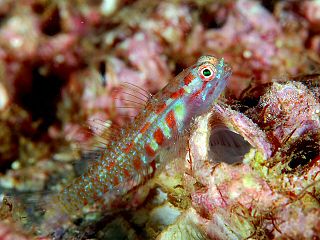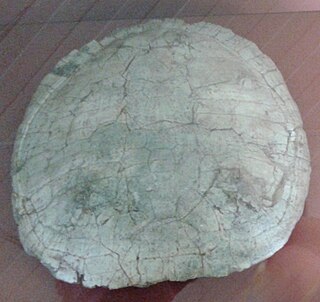
Caenorhabditis elegans is a free-living transparent nematode about 1 mm in length that lives in temperate soil environments. It is the type species of its genus. The name is a blend of the Greek caeno- (recent), rhabditis (rod-like) and Latin elegans (elegant). In 1900, Maupas initially named it Rhabditides elegans. Osche placed it in the subgenus Caenorhabditis in 1952, and in 1955, Dougherty raised Caenorhabditis to the status of genus.

Gobiidae or gobies is a family of bony fish in the order Gobiiformes, one of the largest fish families comprising more than 2,000 species in more than 200 genera. Most of gobiid fish are relatively small, typically less than 10 cm (3.9 in) in length, and the family includes some of the smallest vertebrates in the world, such as Trimmatom nanus and Pandaka pygmaea, Trimmatom nanus are under 1 cm long when fully grown, then Pandaka pygmaea standard length are 9 mm (0.35 in), maximum known standard length are 11 mm (0.43 in). Some large gobies can reach over 30 cm (0.98 ft) in length, but that is exceptional. Generally, they are benthic or bottom-dwellers. Although few are important as food fish for humans, they are of great significance as prey species for other commercially important fish such as cod, haddock, sea bass and flatfish. Several gobiids are also of interest as aquarium fish, such as the dartfish of the genus Ptereleotris. Phylogenetic relationships of gobiids have been studied using molecular data.

The round goby is a euryhaline bottom-dwelling species of fish of the family Gobiidae. It is native to Central Eurasia, including the Black Sea and the Caspian Sea. Round gobies have established large non-native populations in the Baltic Sea, several major Eurasian rivers, and the North American Great Lakes.

Mudskippers are any of the 23 extant species of amphibious fish from the subfamily Oxudercinae of the goby family Oxudercidae. They are known for their unusual body shapes, preferences for semiaquatic habitats, limited terrestrial locomotion and jumping, and the ability to survive prolonged periods of time both in and out of water.

Stiphodon is a genus of freshwater gobies. They inhabit swift, clear streams close to the sea and are found in large parts of Asia and Oceania. Many of the 36 currently recognized species have extremely restricted distributions on single islands or even single streams. These are small gobies with bodies squarish in cross section. A female of Stiphodon multisquamus with a standard length of 60.4mm is the largest Stiphodon individual on record.

Eviota is a genus of fish in the family Gobiidae, commonly as dwarfgobies found in the Indo-Pacific region, where it is distributed from Japan to Australia and from Africa to Pitcairn Island. Species are mainly associated with coral reefs. Many of these fish are short-lived, with life cycles as brief as 3.5 weeks in the tropics. Some species are hermaphrodites and some representatives live symbiotically among the tentacles of the mushroom coral.

The elegant water shrew is a species of mammal in the subfamily Soricinae of the family Soricidae. It is the only species within the genus Nectogale. It lives in Sikkim and China.

The racer goby is a species of goby native to fresh, sometimes brackish, waters, of the Black Sea basin. It is a Ponto-Caspian relict species. The species is placed a monotypic genus, Babka, which was once considered a subgenus of genus Neogobius, but was then elevated to genus-status based on the molecular analysis.

The Gobiiformes are an order of fish that includes the gobies and their relatives. The order, which was previously considered a suborder of Perciformes, is made up of about 2,211 species that are divided between seven families. Phylogenetic relationships of the Gobiiformes have been elucidated using molecular data. Gobiiforms are primarily small species that live in marine water, but roughly 10% of these species inhabit fresh water. This order is composed chiefly of benthic or burrowing species; like many other benthic fishes, most gobiiforms do not have a gas bladder or any other means of controlling their buoyancy in water, so they must spend most of their time on or near the bottom. Gobiiformes means "goby-like".

Periophthalmus is a genus of fish in the family Oxudercidae, native to coastal mangrove wood and shrubland in the Indo-Pacific region, except for P. barbarus from the Atlantic coast of Africa. It is one of the genera commonly known as mudskippers. Periophthalmus fishes are remarkable for being able to live, temporarily, in open air where they feed with insects and small invertebrates; out of water they have limited motion abilities, such as jumping. All Periophthalmus species are aggressive and territorial.

Stigmatogobius sadanundio is a species of goby native to south Asia from India to Indonesia including Sri Lanka and the Andaman Islands. It can be found in mostly fresh waters of estuaries and the tidal zones of rivers. It can also be found in the aquarium trade, where it is often marketed as the knight goby.

True gobies were a subfamily, the Gobiinae, of the goby family Gobiidae, although the 5th edition of the Fishes of the World does not subdivide the Gobiidae into subfamilies. They are found in all oceans and a few rivers and lakes, but most live in warm waters. Altogether, the Gobiinae unite about 1149 described species in 160 genera, and new ones are still being discovered in numbers.

The Gobionellinae are a subfamily of fish which was formerly classified in the family Gobiidae, the gobies, but the 5th Edition of Fishes of the World classifies the subfamily as part of the family Oxudercidae. Members of Gobionellinae mostly inhabit estuarine and freshwater habitats; the main exception is the genus Gnatholepis, which live with corals in marine environments. The subfamily is distributed in tropical and temperate regions around the world with the exception of the northeastern Atlantic Ocean, the Mediterranean Sea, and the Ponto-Caspian region. It includes around 370 species and 55 genera: Wikipedia articles about genera list about 389 species.

Stigmatogobius is a genus of fish in the goby subfamily, Gobionellinae. It is distributed in the Indo-Pacific region, specifically the Indo-Malayan zone. Species can be found along the substrate or hiding in plant litter in freshwater habitat, and sometimes in estuary habitat, such as mangrove stands.

Stigmatogobius pleurostigma is a species of goby from the subfamily Gobionellinae that lives freshwater to brackish water in Southeast Asia.

Bauruemys is an extinct genus of turtles in the family Podocnemididae.

Goby is a common name for many species of small to medium sized ray-finned fish, normally with large heads and tapered bodies, which are found in marine, brackish and freshwater environments. Traditionally most of the species called gobies have been classified in the order Perciformes as the suborder Gobioidei but in the 5th Edition of Fishes of the World this suborder is elevated to an order Gobiiformes within the clade Percomorpha. Not all the species in the Gobiiformes are referred to as gobies and the "true gobies" are placed in the family Gobiidae, while other species referred to as gobies have been placed in the Oxudercidae. Goby is also used to describe some species which are not classified within the order Gobiiformes, such as the engineer goby or convict blenny Pholidichthys leucotaenia. The word goby derives from the Latin gobius meaning "gudgeon", and some species of goby, especially the sleeper gobies in the family Eleotridae and some of the dartfishes are called "gudgeons", especially in Australia.
William Albert Bussing, known as Don William, was an American ichthyologist who spent most of his career on the faculty of the Universidad de Costa Rica, working there from 1966 to 1991. He was appointed professor in 1978 and when he retired he became emeritus professor.
















